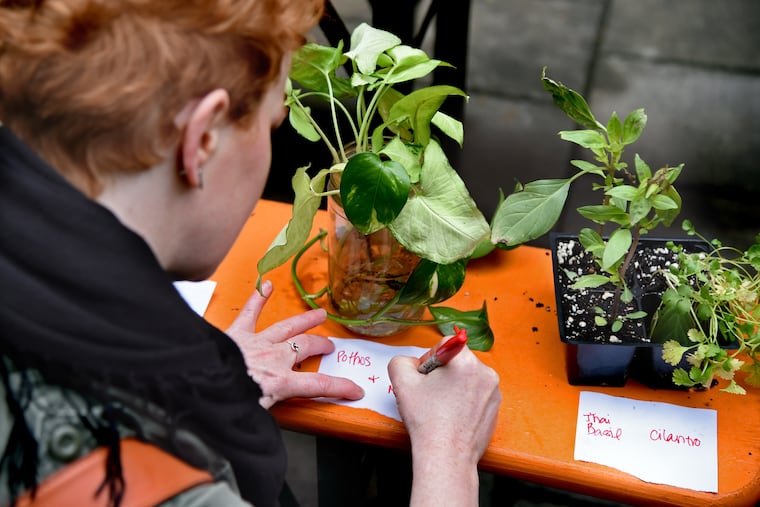Plant swaps: How to get free plants and gardening gear (and make friends, too)
You don't need to bring a plant to swap, but it's good manners.

A plant potluck of sorts amassed on picnic tables at South Street’s PHS Pop Up Garden on a recent weekday evening. Just in time for happy hour, visitors showed up with succulents, eggplant starters, and rubber tree clippings in hand, adding to the spread of hop rhizomes, white flowering Euphorbia Diamond Frost, and other plant offerings already on the table. It was the first PHS plant swap of the season.
“I’m in my happiest place right now,” said Robbie Murphey, arriving with a Thai basil and a pothos plant to give away.
Murphey was one of more than a dozen participants at the event, all eager to talk and trade plants. “You can not only swap plants but swap stories and find other plant buddies,” Murphey said.
Increasingly popular in Philadelphia’s verdant plant community, plant swaps are casual affairs, generally free and open to all — even if you don’t have plants to trade. They happen monthly through September at both of PHS’s pop-up gardens, and in venues like Clark Park and the Maas Building (not to mention people’s living rooms and patios). The surest way to find out about them? Join the thriving Philly Plant Exchange Facebook group.
For everything from plant swap etiquette and trading tips, read on.
What should you bring to a plant swap?
Any pest-free plant. Consider bringing ones you’ve acquired multiples of or ones that, in the words of Marie Kondo, no longer spark joy. Leaf and stem cuttings are also welcome. (Google “plant propagation” if you’re unsure of how to snip a cutting.)
“Don’t bring a dead plant, but if you have a plant that’s not working well for you and it still has life in it, this is the place to give it to someone else who can try to revive it,” said Cristina Tessaro, project manager of the PHS Pop Up Gardens.
You can also show up with gardening gear such as pots, clippers, moss, and spray bottles.
Label your plants with ID and care instructions, and keep packaging in mind. For cuttings, clear Ziploc bags work best. For larger clippings and plants, wrap the roots in a moist paper towel.
“Pots are great, too, but if you show up with a plant in a pot, expect to give both away,” Tessaro said.
How does the swapping part work?
At most swaps, participants put plants on tables and everyone browses and chooses. If you’re more particular, you can hold onto your most coveted plants and try to make specific trades, keeping some advice in mind.
“Direct trades should be of equal value — something like an aloe plant is easy to come by and easy to propagate, so don’t expect to hang onto those kinds of plants,” said Nakia Maples, the owner of more than 300 houseplants and an annual plant swap host in his South Philly home. “It you want something rare, bring something rare.”
What’s good plant swap etiquette?
Given the free-form nature of a plant swap, there aren’t too many rules. At the start, only take as many plants (or items) as you brought. If there are leftovers and you stick around to the end, you can snag more. Those who don’t have any plants to share are more than welcome to attend, but should wait until the end before picking out any of the offerings.
“It’s about plant enthusiasm — getting people interested in plants is the number-one goal, so showing up empty-handed is fine as long as you aren’t being greedy at the start,” Maples said.
“People are very welcoming and giving in this community,” Tessaro affirmed.
Timing is crucial, though — showing up fashionably late will not work in your favor. In fact, arrive a little early if you wish to be among the first to pick out whatever you want from the swapping table. People are always coming and going, so you may wish to stick around for the entire event to see what shows up.
If you take something home that doesn’t work out in your space, bring it back. There’s no shame in that.
Are plant swaps fun?
At all plant swaps, time to socialize is built in. Beer is often served. PHS Pop Up Garden swaps feature $5 margaritas.
“I remember the first plant swap I attended and how nice it was to finally connect in person with some of these familiar faces I always saw posting in Philly Plant Exchange,” Tessaro said. “These attract people from all different parts of the city and even beyond city lines, so you get this wide variety of living experiences — people with larger yards to people who can only garden on fire escapes — all connecting over plants and sharing their learnings from different situations.”
If you’re struggling to figure out why the leaves of your succulent are falling off, or why your orchid looks like it’s about to take its last breath, swaps create a prime place to brainstorm and problem-solve.
“You get to ... gain knowledge while meeting new people,” Maples said. “Philly’s plant community is unbelievable.”
The next regularly scheduled PHS plant swap happens from 6 to 8 p.m., July 18 at the University City Pop Up Garden at 36th and Filbert Streets; see phsonline.org/events for more information.